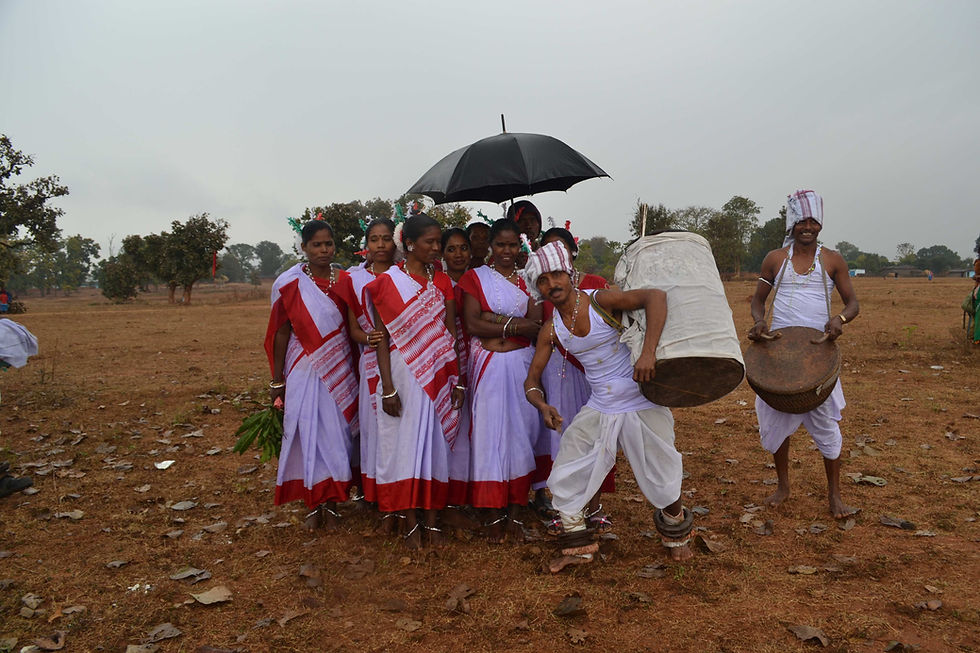Adivasi Dance And The Culture Of Collectivism
- Abhay Xaxa

- Mar 14, 2021
- 3 min read
Dance is an important representation of culture and art in all societies. When it comes to Adivasi/indigenous communities, dance not only plays a central role in their identity formation but also in communicating their worldview. There is a popular proverb among Oraon Adivasis, which goes, “Ekna dim tokna, Baa’na dim parna,” meaning, “Walking is dancing and talking is singing.”
Among the Adivasi communities of India, dance is an inalienable part of their rituals, customs, and culture. It is not just cultural expressions of the community, but a reflection of their philosophy and more importantly, it is a repository of their collective knowledge and wisdom.

There are thousands of dance traditions, but Adivasi dance forms stand apart because of their strong connection with the culture of collectivism. The symbolic message of “working together, living together and dancing together” is communicated to all community members through their beautiful songs and dances.
The single most defining feature of Adivasi dance is its deep-rooted connection with nature. No matter what the season, life cycle, socio-cultural cultural context or human emotions that prevail, interacting with nature is the cross-cutting theme in all Adivasi dances. Although there are hundreds of Adivasi dance forms and are linked to special festivals, occasions, and life-cycle events, some have become more popular than others. Some of the most popular ones include Karam dance among Oraons, Baha Dance among Santhals, Ghoomar among Bhils, and Timli dance among the Adivasis of Gujarat.

Singers invoke nature in its various forms and call them friends, relatives, mentors, and well-wishers. Trees, leaves, birds, animals, mountains, rivers, forests, the whole natural world is invited into an Adivasi dance with love and affection. Often the leader of the group will hold a branch of a tree and the team will decorate themselves with flowers making a deep connection with nature. Adivasi philosophy views nature and human beings as hybrids, where they both are inseparable partners, and this is clearly displayed in their dance acts.
Another distinctive feature of Adivasi dance is that it is a non-spectator performance where all members irrespective of their age, gender or religion come together as a group with highly synchronised beautiful body movement to the rhythm of Mandar or Nagada.
Unlike other traditional dances in the Indian subcontinent, Adivasi dances are never an individualistic indulgence but are performed in large groups with complex coordination of body movements by all members. It is important to note that all members of the dancing group are connected to each other through body touch, either by holding hands or gently touching the waist. The sense of rhythm and movement is communicated to each other through these connections of touch. Body touch among Adivasi dancers also builds feelings of trust and togetherness among its group members.

Adivasi dances are never taught in any formal setting like students of classical Indian dances are. Children learn it by joining dances with their elder siblings, friends, parents or elders. It is a very special feeling of belonging when younger ones are included in larger dance groups where they can share their emotions and match their body movements with others. In an Adivasi community, dancing together becomes a process in schooling on culture and rituals of the group.

Just like other indigenous cultures, dance performances of Adivasis hold important symbolic value and socio-cultural messages. Almost all the Adivasi dances create circular or semi-circular formations of dancers, which symbolically communicate unity, peace, strong sense of community belonging. It also infuses the ideology of collectivism, which has become an integral part of Adivasi identity and culture. Strong belief and alliance with Adivasi beliefs, customs, rituals, and traditions are affirmed through their collective performance. The ideology of community over the individual, selflessness over selfishness, cooperation over greed is transferred from one generation to another through the beautiful cultural education of dance in Adivasi communities.
About the author: Dr. Abhay Xaxa, a renowned activist, poet, and scholar, passed away on March 14, 2020 from a heart attack. Xaxa had a Ph.D. in Sociology from Jawaharlal Nehru University and was the recipient of the Ford Foundation International Fellowship Programme. He worked with the National Campaign for Adivasi Rights and used to write on issues related to the Indigenous Peoples in India. This article was first published on www.youthkiawaaz.com




Comments